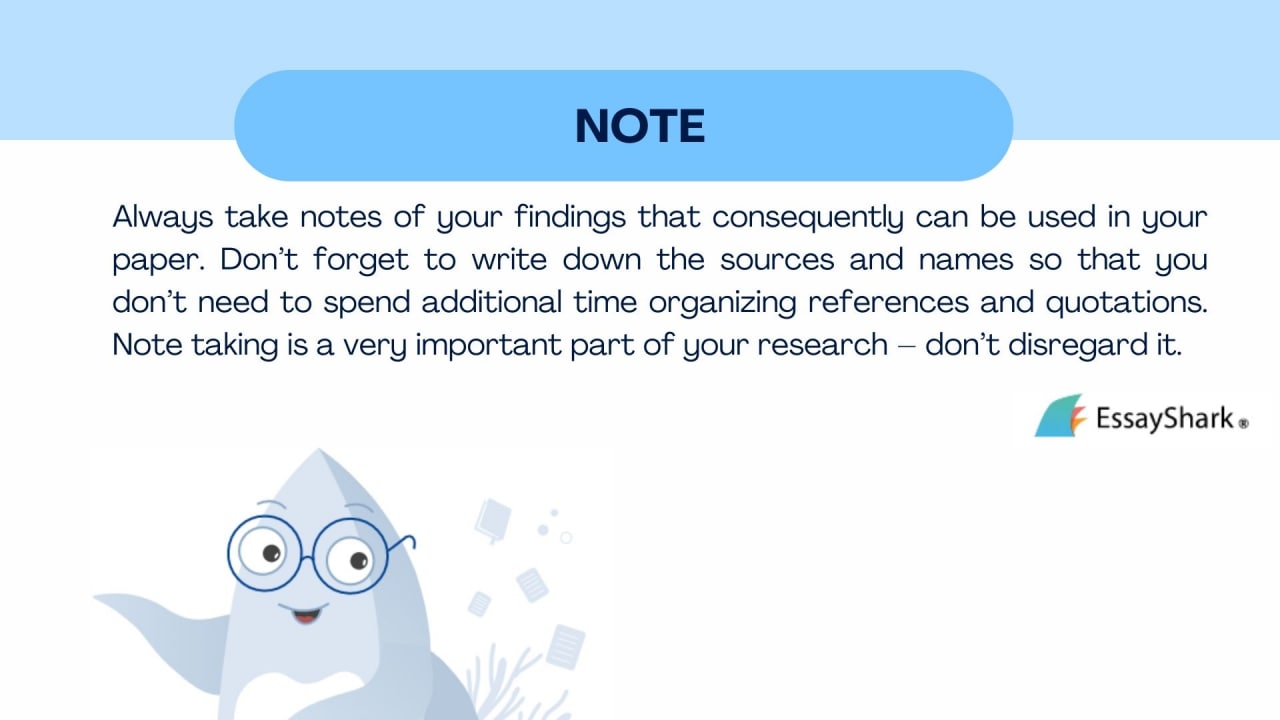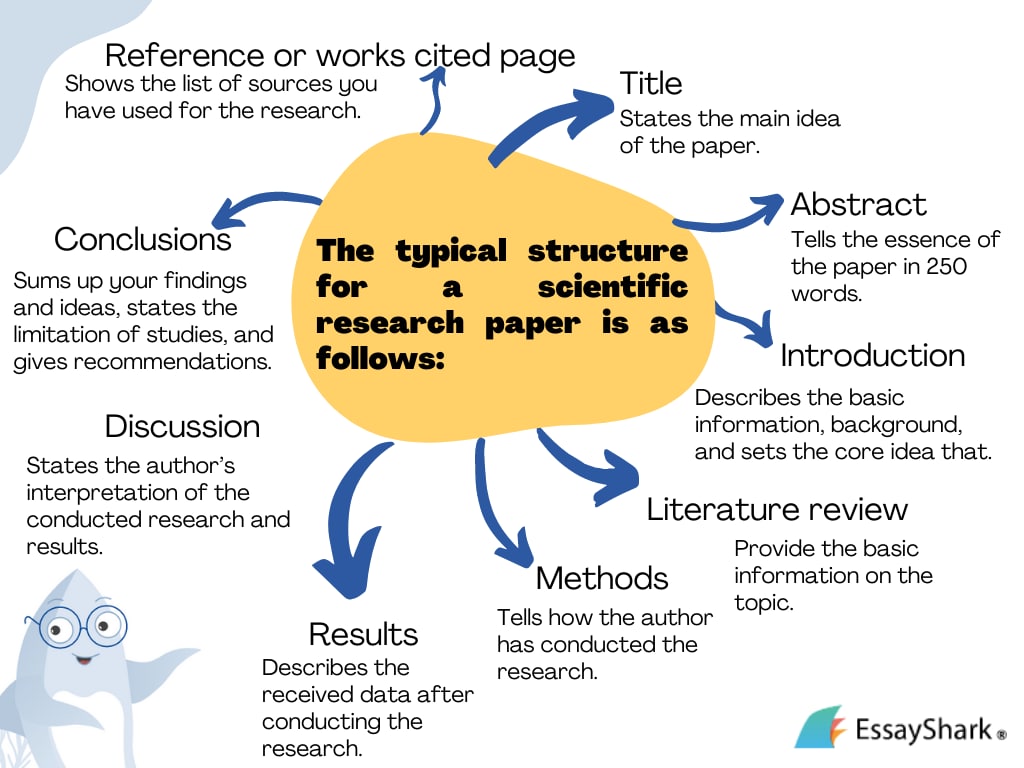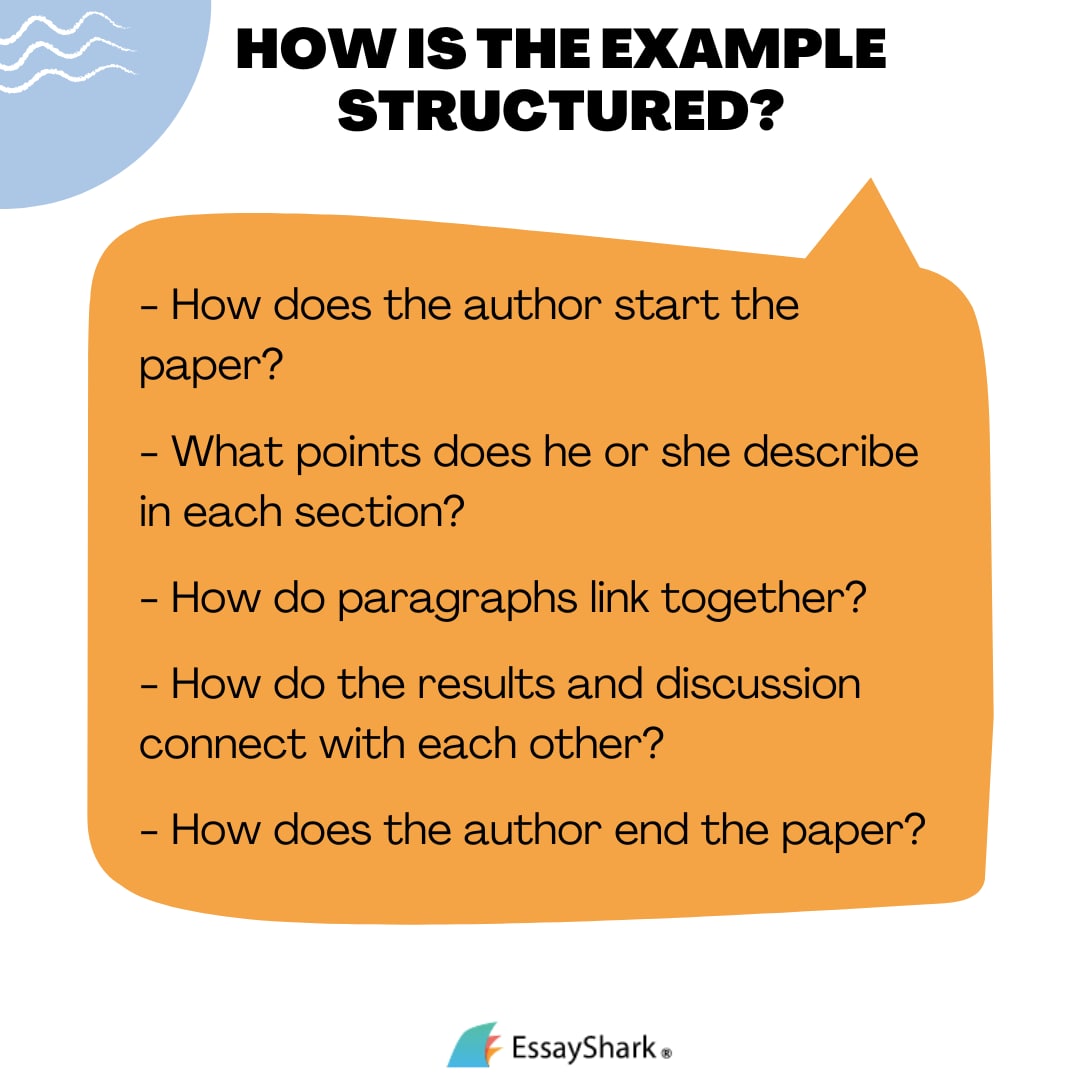In this guide, we explain how to write a research paper step by step.
You’ll learn what to do before writing, including how to choose a good topic for your paper, how to outline and structure it, and how to revise it after the draft is complete. You’ll find several research paper examples from our experts and get answers to the most frequently asked questions students have about this type of assignment.
So, let’s get right into the details.
Table of contents
- What Is a Research Paper?
- Before Writing
- Research Paper Structure
- How to Write a Research Paper: 9 Steps
- Topic Ideas for Your Research Paper
- Top 10 topics for a research paper
- Research Paper Formatting Tips
- Top Resources for Writing a Research Paper
- How to Write a Research Paper Fast
- 5 Research Paper Examples from EssayShark
- FAQs
- How Essay Shark Can Help With Research Paper Writing
What Is a Research Paper?
A research paper is an academic writing piece that analyzes, evaluates, and interprets a topic. Based on empirical evidence, it emphasizes the use of statistical data and preexisting research.
Research papers require formal, unbiased language and a strict code for citations. You should state your findings with corresponding evidence so that others can later use your paper in their research.
It’s a common assignment in school and college:
Educators assign research papers to test your knowledge of a particular area and academic writing skills.
The length of your paper may vary depending on the topic or assignment. Complex issues requiring extensive research and more explanations will run around 4,000–6,000 or even 10,000 words, while the standard length for research papers in school is around 2,000 words.
Check your assignment carefully before you start working on your research paper. Your teacher might provide a recommended length along with the other requirements.
Before Writing
You can’t just sit down and start writing a draft for your research paper. The process requires a lot of pre-writing work. Let’s see what you need to do:
1. Make sure that you understand the assignment
Read the writing prompt carefully. Every detail you have there will help you craft a stellar paper that is worthy of high grades. Pay attention to the following:
- The topic
- The technical requirements: the length, format, citation style, and structure you’ll need to follow. Do they want you to craft a cover page? Do they expect you to write an abstract?
2. Choose a topic
When you are given no particular topic for the assignment, you’ll have to choose one yourself. You can find lots of research topics for college students in Internet, but please note:
A good topic for a research paper will differ from a good topic for a standard college essay.
How to choose a topic for a research paper:
- Avoid general topics. Narrow them down to cover a particular aspect of the issue. For example, writing about child abuse (in general) is okay in an essay. Still, a more specific topic, like how child abuse influences a child’s well-being (or how to treat a particular kind of abuse trauma), would be a better fit for a research paper.
- Choose topics that are interesting for you to cover yet relevant to your course of study. In other words, refrain from researching your favorite music group when writing a psychology paper. However, you can research the development and influence of a particular musical style when writing a paper on history or sociology.
- Consider topics with enough scientific content and background. You’ll need preexisting research to analyze in your paper and add to your bibliography.
3. Conduct preliminary research
When students wonder how to write a research paper, they focus more on technical details, such as what to mention in every section. Come on, guys, it’s a research paper, after all:
You’ll have nothing to write about until you conduct preliminary research to find out what others have already said about your topic. Search for credible sources to analyze and evaluate the existing information so that you can prepare your thesis statement.

A thesis statement is a core idea summarizing what your research paper will be about. It will help to craft it before you start writing a draft, as it will determine the paper’s structure, the arguments you’ll use, and the discussion you’ll offer to interpret your findings and ideas.
Research Paper Structure
Even if you know how to write a good essay, you won’t necessarily be able to craft a stellar research paper, as the two have different structures. While a standard college essay consists of three parts, a research paper includes a minimum of six:
- Abstract
- Introduction
- Methods
- Results
- Discussion
- References
Depending on the subject, complexity, and length, your research paper may contain a Title Page, a Literature (Literary) Review, Tables and Figures, and an Appendix.

Let’s review what each section includes:
- Title Page. This is like a book cover containing a paper’s name as well as its author’s name and institutional affiliation.
- Abstract. This is a one-paragraph summary of your paper, providing an overview of your entire study.
- Introduction. This first significant section of the research paper describes the topic, summarizes prior research, and introduces the unresolved issues the paper will address.
- Literature Review. Add this section to your paper if you aren’t presenting any new research but instead reviewing previously published research on the topic. In this case, you won’t need the Methods and Results sections but will have to discuss different aspects of the reviewed resources in the body. Also, you’ll have Conclusions instead of a Discussion section.
- Methods. This section describes the methodology you used to conduct research: the participants involved, the materials you used, the study design and procedures you performed, etc. Make this section detailed enough for another researcher to duplicate your study if necessary.
- Results. This part of your paper describes the data you’ve gathered and the results of any qualitative or quantitative tests you performed. If you had more than one hypothesis and conducted several experiments, then you must write a separate Results section for each.
- Discussion. The final significant section of your paper is a summary of the results you obtained and how these results address the issues under investigation. In plain English, describe the significance of your results and address limitations and directions for future research.
- References. An alphabetized list of the sources you cited in the paper. Each reference should follow specific formatting guidelines, depending on your citation style (APA or MLA).
- Tables and Figures. Depending on the type of research you conducted, you may add these additional materials as separate pages after your References.
- Appendix. This is an optional section presenting supplementary information on your research (a list of experimental stimuli, programming code, etc.).
How to Write a Research Paper: 9 Steps
Let’s recap the three steps you need to take before writing a paper:
- Understand the assignment
- Choose a topic (if none is assigned in the task)
- Conduct preliminary research to formulate a thesis
How to write a thesis for a research paper:
Rephrase the topic of your paper as a question and then answer it based on your preliminary research. Your thesis statement should summarize what your paper will be about:
Mention all the important parts without disclosing too many details for the audience to understand whether your research will be helpful to them. Make your statement informative yet intriguing to encourage a person to keep reading.
Now, it’s time to do the actual research and start writing. Once your thesis statement is ready, your next steps will be as follows:
4. Find supporting evidence
Go through the resources you found during your preliminary research and determine the information you’ll use in your paper.
For that, read each source and note the arguments and data that are relevant to your topic. Write down all the numbers: You’ll later use them for citations.
To speed up the process of researching and organizing resources, use their annotated bibliographies. (A bibliography is a summary and evaluation of each source that will help you understand its context and whether it’s relevant and worthy of further investigation.)
5. Outline your research paper
So, now you have a list of the resources you want to research and discuss in your paper. How will you present them coherently and logically? Think of an organized and systematic structure you can use to address all the issues and support them with evidence:
Craft an outline.
This is a table of contents for your research paper. Think of the best order to present your information in and list the subtopics you’ll cover. Break the outline into paragraphs, each with the supporting evidence you’ll use. This will give you direction and control over the paper’s flow and help you stay organized while writing.
6. Write the first draft
Follow your outline and write your research paper section by section. Feel free to start from whatever is more comfortable: You can write a literature review and then continue with the introduction, or you can describe your methodology first and then move to the abstract.
Choose the order that suits you best, but ensure that you get everything.
How to write an abstract for a research paper:
- Write a summary (150-250 words) of what your paper will be about.
- What to include: the specific topic and context of your research; the central questions (problems) you’ll address; the rationale (goals) of your research; your findings (in short) and their significance
Tip: Write an abstract after you’ve drafted your research paper so that it’s easier to summarize what you’ve already described.
How to write an introduction for a research paper:
- Start with your thesis statement, introducing the topic to readers.
- Continue with the background information to keep them interested.
How to write a conclusion for a research paper:
- Restate your thesis.
- Summarize your findings.
- Interpret the results, specifying the significance of your research to further investigations in your scientific niche.
- Make sure you don’t mention any new information in the conclusion.
7. Cite your sources
Now, it’s time to organize your reference list. Check the assignment again to see which citation style you need to use — and format the list accordingly.
As a rule, research papers follow one of these formatting styles:
- APA (American Psychological Association) for disciplines like psychology, sociology, education, engineering, business, nursing, and others
- MLA (Modern Language Association) for disciplines like language, literature, cultural studies, and others
Each has a detailed guidebook specifying the formatting rules for different sources including books, journals, websites, photos, videos, etc. Check the guidebook when you doubt whether you’ve put a given author’s name, publishing year, or comma in the right place.
8. Edit your research paper
Once your draft is ready, it’s time to check it and revise all the weak points and mistakes. Here’s a proposal:
Don’t start the editing process right after you finish the draft. Writing is energy-consuming, so you won’t have enough focus and mental clarity to handle editing right after you put in the last period. Set the paper aside for a day or two and check things out later with fresh eyes.
This will allow you to be more attentive and notice the flaws you’d miss if you reread the text when tired. A fresh perspective will also create an emotional distance between you and your text: You’ll see it as a reader and editor, rather than an author, and be more objective.
If you don’t have much time to wait, take a small break at least. Go for a walk in a park, have a cup of tea somewhere away from your laptop, you name it! You’ll change your perspective and then go back to work rested.
When editing, check that:
- Your thesis is concise and clear
- Your paper is well-structured, flowing from section to section with logical transitions
- Your arguments support your thesis
- Your ideas flow logically in each paragraph
- You’ve used credible evidence to support your arguments
- You’ve avoided generalizations and repetitions in the paper
- You’ve given credit to all the resources you cited in the paper
9. Proofread and submit your text
The final step:
Read your paper aloud to catch any tiny errors you might have missed during the previous revisions: typos, grammatical mistakes, weird or hard-to-read words and sentence structures, etc.
When proofreading, ensure that:
- The text has proper spelling, grammar, and punctuation
- Your language is clear and specific (Avoid filler words and phrases)
- Your sentences and paragraphs flow smoothly
That’s it!
Your research paper is ready to be submitted for the teacher’s review and bring you a high grade.
Topic Ideas for Your Research Paper
Let us quickly remind you:
A good research paper topic is specific, engaging, relevant to your course, and has research potential.
Below are some topic ideas you can use for your paper. (Please do your best to revise and adjust them for relevance and adherence to your assignment’s requirements.)
Top 10 topics for a research paper

Research Paper Formatting Tips
Understanding how to write a research paper also includes learning about the formatting guidelines for this type of academic document. Read your assignment carefully, as it often contains all the stylistic and formatting requirements you need to follow. Pay attention to these details:
- Word count
- Title page formatting (check if they require this page at all)
- Running heads (to use or not to use?)
- The citation style for sources (APA or MLA)
- The format to save your text in (DOCX, PDF, etc.)
- Font size, spacing, margins
- The tone of voice (formal, with no “I” statements, with passive voice and past tense for describing experiments in your paper)
- The formatting requirements for graphs, tables, diagrams, and other visuals
When you are given no particular guidelines in your assignment, format your research paper according to the general formatting rules:
| Word count Font Margins Spacing Page numbers Spaces Citation style | 2,000+ words 12 point, Times New Roman 1-in. on all sides Double At the top right; a Title Page numbered page 1, the Abstract — page 2, and the text (starting with the Introduction section) on page 3 Two spaces after the punctuation marks at the end of each sentence APA (in alphabetical order by the last name of the first author of each source) |
Top Resources for Writing a Research Paper
You already know how to craft a research paper, so you understand there’s no way to do it without including credible sources in your reference list. The science and preexisting research materials on the topic are the foundation of your research paper.
What resources are credible and trustworthy enough to use?
- Websites ending in .edu and .gov
- Online encyclopedias (No using Wikipedia as a primary source, please! You can check its articles for a list of references.)
- Public, university, and online libraries (The Library of Congress is the perfect resource for academic research.)
- Non-fiction books (Google Books can help you find relevant publications.)
- Scientific journals with scholarly articles (Try Google Scholar to find them.)
- Studies and publications in reputable media outlets (Consider academic databases like Scopus, Clarivate, PubMed, etc.)
- Reports from scientific conferences
How to Write a Research Paper Fast
Is the deadline looming, and you’re searching for instruments or tactics to boost your writing speed?
Here’s how to write a research paper fast:
1 – Organize your workplace for better productivity
Choose a quiet corner with minimal traffic and other distractions but with proper lighting, a comfortable table and chair, and a green plant nearby. Prepare all the tools you’ll need (a laptop, a pen, a notebook, books, and other materials) and place them nearby.
2 – Research and outline your paper beforehand
Academic writing isn’t only about putting words on paper. You know your deadline, so why not do all the pre-writing work with it in mind? Do your preliminary research, organize all the resources, craft an outline — and you’ll write your draft super fast.
Cut the writing into time blocks to know how many hours (or minutes) you’ll have to complete each section of your paper. If you feel stuck on the introduction, write the body of your paper first.
3 – Use tools
Ready-made templates are great assistants! Craft and save the outline templates for various research paper structures, formatting guidelines, and reference lists; take a corresponding template when necessary and fill in the gaps with the relevant components.
Try speech-to-text programs. Dictate your paper out loud to convert it into text. Use grammar checkers to speed up proofreading and editing, or delegate this process to the professional editors at EssayShark.
Consider using an essay rephraser for free to save time when describing the prior research on your topic. Paste in the source text and get a new, original description to place in your Literature Review section.
Here’s a checklist you can use to finalize your paper before you submit it to your executive:
? I followed all the instructions from my assignment.
? My topic is specific, research-based, and relevant to my discipline.
? I stated a clear thesis and provided all the necessary background information in my introduction.
? I structured my research paper with all the required sections in mind.
? I cited all resources using the required citation style.
? My conclusion provides a concise answer to the research question.
? I specified the significance of my research to the niche.
? I crafted the reference list according to the formatting rules provided in the assignment.
? My research paper has a logical structure and flow.
? I revised and proofread my paper so that it’s free from spelling, grammatical, punctuation, and stylistic mistakes.
5 Research Paper Examples from EssayShark
It’s better to see once than hear twice, right? The best way to learn how to write a research paper is to read several ready-made examples from professional academic writers. We’ve gathered five from our experts that you can check and use as templates for your future papers.
Please don’t copy them word for word to submit for the teacher’s review as your own. They are here for informational and educational purposes only. Consider them a trigger to boost your writing flow when you feel stuck and don’t know how to state a problem or conclude your paper.
The examples’ structure:

As you read them, feel free to take note of the useful phrases or transitional words the author uses. Please pay attention to how they structure a paragraph, describe the research results, and so on. All these details will come in handy when you write your paper.
So, here are the examples:
- Sample APA Research Paper About Depression (This is extra helpful for medical students. Take a closer look at the introduction and how the author organizes references in this publication.)
- Ethereum Research Paper Sample (Follow the author’s research on cryptocurrency. Check how he moves from one paragraph to another to maintain a comprehensive and logically flowing narrative.)
- History Research Paper Sample About The Britain-American Relationship (Please note that it’s okay to title each paragraph of your research paper for better readability and navigation. This sample is incomplete, but it is essential for seeing how to format in-text citations.)
- Workplace Gender Inequality Research Paper Sample (Check this sample if you need to write a sociology paper. Learn how to introduce your topic and thesis in the opening paragraph in a way that encourages the audience to keep reading.)
- Impressionism Research Paper Sample: The Hierarchy of Subject Matter in Art (Check how to craft a conclusion and format the reference list for your research paper.)
FAQs
Below are the answers to the top five most common and frequently asked questions college students have on how to write a research paper. This section is for you if you’ve scanned this article craving concise info instead of a long read.
What are the parts of a research paper?
A research paper has six core parts: Abstract, Introduction, Methods, Results, Discussion, and References. Depending on the discipline and the topic you cover, it’s also possible to include optional Tables & Figures and Appendix sections.
Your executive may ask you to craft a Title Page specifying the title, your name as an author, your institution, and other related information. If you don’t conduct any research experiments but rather review preexisting research on your topic, you won’t need the Methods and Results sections, but add a Literature Review after the Introduction.
How do I outline a research paper?
An outline is a table of contents for your future paper. Here, you organize all the information you’ve gathered during your preliminary research and decide how to structure and present it to readers. Here’s how to write an outline for a research paper:
- Start with a thesis
- List all the subtopics you want to cover
- Create the framework
- Add the details to mention in every section
How do I start writing my research paper?
First, read the assignment and ensure that you understand all the requirements: the topic, length, formatting guidelines, citation style for references, etc. Then, do research to find credible resources on your topic to refer to in your paper. Finally, develop the thesis statement you’ll support and prove, structure your paper by organizing all the arguments and evidence, and start writing a draft.
Conclude with the Results section. This is how to write a conclusion for a research paper:
- Restate your thesis
- Summarize your findings and interpret them for the audience
- Specify the significance of your findings to further research in the niche
How to write a research paper introduction?
The introduction is the first significant section of your research paper. It comes after the Abstract, introducing your topic and its background to readers. Start with your thesis statement, briefly introduce existing research on your topic, and talk about the unresolved issues (i.e. the knowledge gap) you’ll address in your paper.
How to write a good research paper?
A good research paper is one you have enough time to craft, covering a topic of interest to you. Here’s how to write a good research paper:
- Choose a specific, relevant topic with research potential
- Form a clear thesis
- Find, read, and analyze the resources you’ll use as evidence to prove your thesis
- Craft an outline
- Write the body of the paper
- Organize the reference list
- Proofread and edit your research paper
How Essay Shark Can Help With Research Paper Writing
This ultimate guide, full of details and examples, will help you better understand how to write a research paper. Here are the takeaways:
- Check and follow the assignment.
- Choose a specific and relevant topic for your paper.
- Outline it, following the structure.
- Format it according to the prescribed requirements (the cover page, word count, citation style, etc.)
- Edit and proofread your draft before submitting it for your teacher’s review.
You can buy a research paper, if you can’t handle it yourself. EssayShark’s academic writers and friendly support team are ready to assist you with any questions. We write papers in 50+ disciplines, including business, economics, psychology, history, art, philosophy, and law. So, we are always here to help!








